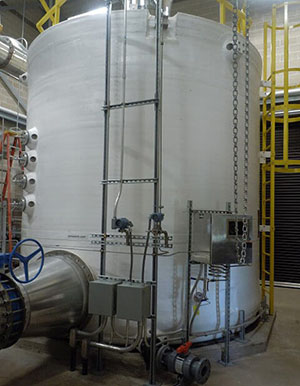
Wastewater treatment plants ‘produce’ a cleaned water stream and a dewatered sewage sludge product. To dispose of the sludge, many wastewater treatment facilities employ a sewage sludge incinerator (SSI). The types of SSIs used at wastewater treatment facilities include fluidized bed incinerators and multiple hearth furnaces.
USEPA regulates air pollutant emissions from SSIs at wastewater treatment facilities. One set of such emission limits applies to ‘existing’ SSIs (as of 2010) that demonstrated initial compliance on or before March 2016 (40 CFR Part 60 Subpart MMMM, or ‘Subpart MMMM’ limits). New or modified SSI units, in contrast, must meet significantly more stringent air emission limits, contained in Subpart LLLL; a small handful of such new or modified SSIs have been beginning to demonstrate compliance over the last few years.
One SSI in the eastern U.S. – using APC’s air pollution control equipment for mercury emissions control, dioxins & furans emissions control, and particulate matter (PM) emissions control – in 2021 became one of the few such ‘new’ incinerators in the U.S. to comply with the more stringent Subpart LLLL emission limits. APC’s equipment was guaranteed to meet, and successfully met, the LLLL emission limits for mercury and dioxins & furans coming from the SSI. This mercury control system and dioxins-furans emission control system, along with all of APC’s other similar systems operating on other SSIs, has a flawless safety and reliability record, provides low operating costs, and requires little maintenance.
PC’s standard air pollution control system offering for SSIs is an activated carbon system, which is long established as the technology of choice where high removal efficiency (i.e., 99%) is needed for mercury removal and dioxins-furans removal. Where additional organic hazardous air pollutants (HAPs) control is needed as part of a facility’s air permit, APC guarantees the removal performance required for those contaminants as well, since the same equipment – an activated carbon adsorption system – is again the technology of choice for removing organic hydrocarbons from air exhaust streams and has been successfully used for this purpose for decades.
APC’s standard air pollution control system for SSIs further provides an extremely high degree of particulate matter removal, not only to protect the activated carbon bed from any PM but also to help the WWTP ensure that stringent emission limits are met for PM and regulated metals emissions including cadmium, lead, and beryllium at some locations.
APC’s mercury, dioxins-furans, and HAPs control systems operating at SSIs collectively have over 30 system-operating years – with a fully safe and high reliability record. Activated carbon adsorption is not only completely safe but is the only effective technology that provides 99% removal of these contaminants. Activated carbon has demonstrated this ability for decades on exhaust emissions in dozens of industries.
More information on APC’s emission control systems for SSIs can be found at: https://www.apctechnologies.net/control-of-mercury-emission-for-sewage-sludge-incinerators-ssi/. Please contact APC to discuss your air emission control system needs.

